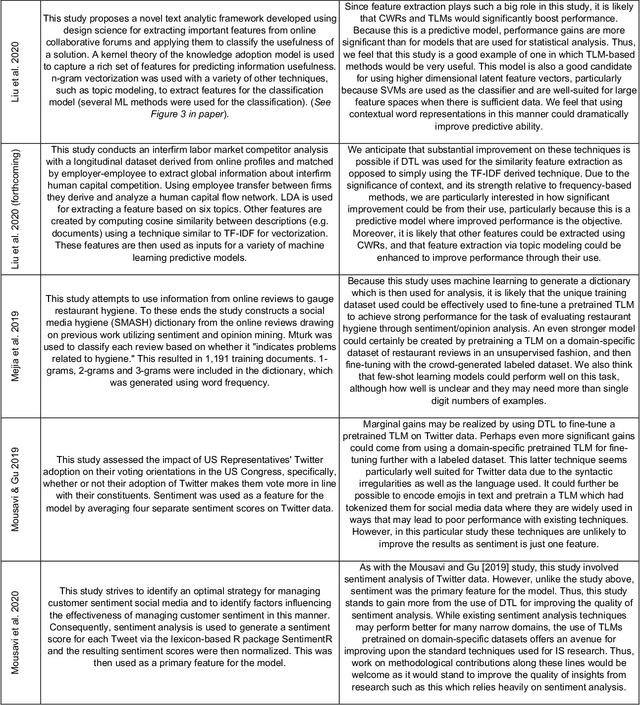David Paradice
Deep Transfer Learning & Beyond: Transformer Language Models in Information Systems Research
Oct 23, 2021
Abstract:AI is widely thought to be poised to transform business, yet current perceptions of the scope of this transformation may be myopic. Recent progress in natural language processing involving transformer language models (TLMs) offers a potential avenue for AI-driven business and societal transformation that is beyond the scope of what most currently foresee. We review this recent progress as well as recent literature utilizing text mining in top IS journals to develop an outline for how future IS research can benefit from these new techniques. Our review of existing IS literature reveals that suboptimal text mining techniques are prevalent and that the more advanced TLMs could be applied to enhance and increase IS research involving text data, and to enable new IS research topics, thus creating more value for the research community. This is possible because these techniques make it easier to develop very powerful custom systems and their performance is superior to existing methods for a wide range of tasks and applications. Further, multilingual language models make possible higher quality text analytics for research in multiple languages. We also identify new avenues for IS research, like language user interfaces, that may offer even greater potential for future IS research.
Alternative Techniques for Mapping Paths to HLAI
May 02, 2019
Abstract:The only systematic mapping of the HLAI technical landscape was conducted at a workshop in 2009 [Adams et al., 2012]. However, the results from it were not what organizers had hoped for [Goertzel 2014, 2016], merely just a series of milestones, up to 50% of which could be argued to have been completed already. We consider two more recent articles outlining paths to human-like intelligence [Mikolov et al., 2016; Lake et al., 2017]. These offer technical and more refined assessments of the requirements for HLAI rather than just milestones. While useful, they also have limitations. To address these limitations we propose the use of alternative techniques for an updated systematic mapping of the paths to HLAI. The newly proposed alternative techniques can model complex paths of future technologies using intricate directed graphs. Specifically, there are two classes of alternative techniques that we consider: scenario mapping methods and techniques for eliciting expert opinion through digital platforms and crowdsourcing. We assess the viability and utility of both the previous and alternative techniques, finding that the proposed alternative techniques could be very beneficial in advancing the existing body of knowledge on the plausible frameworks for creating HLAI. In conclusion, we encourage discussion and debate to initiate efforts to use these proposed techniques for mapping paths to HLAI.
Forecasting Transformative AI: An Expert Survey
Jan 24, 2019



Abstract:Transformative AI technologies have the potential to reshape critical aspects of society in the near future. However, in order to properly prepare policy initiatives for the arrival of such technologies accurate forecasts and timelines are necessary. A survey was administered to attendees of three AI conferences during the summer of 2018 (ICML, IJCAI and the HLAI conference). The survey included questions for estimating AI capabilities over the next decade, questions for forecasting five scenarios of transformative AI and questions concerning the impact of computational resources in AI research. Respondents indicated a median of 21.5% of human tasks (i.e., all tasks that humans are currently paid to do) can be feasibly automated now, and that this figure would rise to 40% in 5 years and 60% in 10 years. Median forecasts indicated a 50% probability of AI systems being capable of automating 90% of current human tasks in 25 years and 99% of current human tasks in 50 years. The conference of attendance was found to have a statistically significant impact on all forecasts, with attendees of HLAI providing more optimistic timelines with less uncertainty. These findings suggest that AI experts expect major advances in AI technology to continue over the next decade to a degree that will likely have profound transformative impacts on society.
 Add to Chrome
Add to Chrome Add to Firefox
Add to Firefox Add to Edge
Add to Edge